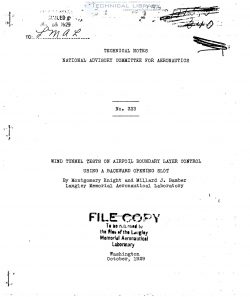naca-tn-323
- Version
- 210 Downloads
- 476.91 KB File Size
- 1 File Count
- November 4, 2016 Create Date
- November 4, 2016 Last Updated
National Advisory Committee for Aeronautics, Technical Notes - Wind Tunnel Tests on Airfoil Boundary Layer Control Using a Backward Opening Slot

This report presents the results of an investigation to de—
termine the effect of boundary layer control on the lift and
drag of an airfoil equipped with a backward opening slot. Var—
ious slot locations, widths of opening, and pressures, were
used. The tests were conducted in the Five—Foot Atmospheric
Wind Tunnel of the Langley Memorial Aeronautical Laboratory.
The greatest increase-in maximum lift Was 96 per cent, the
greatest decrease in minimum drag was 22 per cent, and the
maximum lift coefficient. Minimum drag coefficient was greatest
increase in the ratio 151 percent.
This preliminary report gives in brief the results of an
airfoil boundary layer control investigation made to determine
the effect of slot location, size, pressure maintained on the
inside of the wing, and the quantity of air flowing through the
slot. These tests were made in the Five—Foot Atmospheric Wind
Tunnel of the Langley Memorial Aeronautical Laboratory, and
were a continuation of those described in Reference 1. The
backward opening type of slot was.used because, in the former
tests, this type of slot, when not in operation, gave the least
detrimental effect upon the aerodynamic characteristics of the
airfoil. The complete results of this investigation will be
published in a later report.
The tests were made on an airfoil equipped with a rearward
opening slot which Was adjustable both as to width and location
along the chord. A sketch of the slot and its proportions is
shown in Figure l.
The H.A.C.A. 84—M profile was used. A sketch of this pro—
file is shown in Figure 2, together with the locations of the-
slot along the chord.
The hollow airfoil of 15—inch chord and 25—1/4—inch span
was mounted vertically between two large horizontal planes at
its ends. This arrangement gave practically two—dimensional
air~flow conditions, and made it possible to conduct the air
for the slot to or from the interior of the wing (by means of a
mercury seal) without affecting the measurement of the forces.
The quantity of air flowing through the slot Was measured by
means of an orifice meter.
| File | Action |
|---|---|
| naca-tn-323 Wind Tunnel Tests on Airfoil Boundary Layer Control Using a Backward Opening Slot.pdf | Download |

Comment On This Post